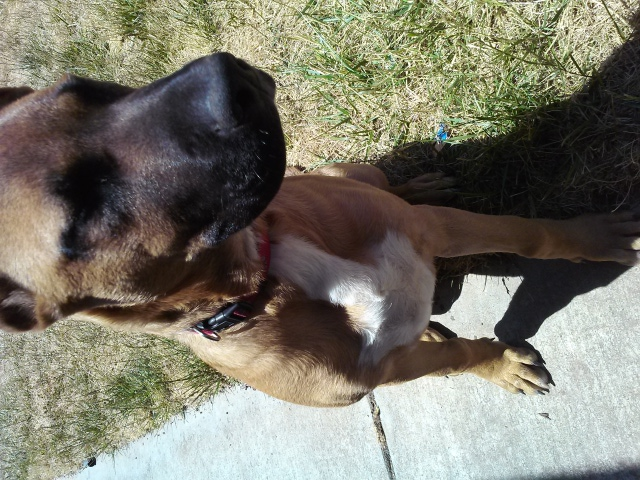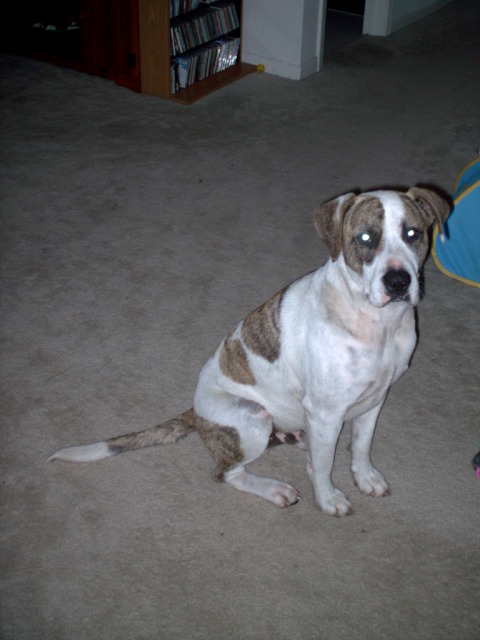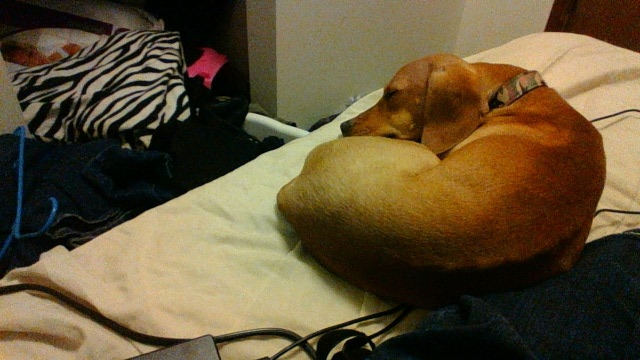QuestionQUESTION: Dear Shelley,
My Bolognese is eight and a half years-old. He is extremely attached to me, he's been with me since he was eight months old.
We've recently moved to NYC from across the Atlantic, and it seems like he cannot get used to staying alone in the new apartment. I have to admit that he's rather spoiled that way; for the past eight years, I've been organizing my schedule around him. :/
I need to be away for about seven hours a day.
Whenever I go out at night -- when I do, I make sure he's with me all day, -- he makes a LOT of noise. Not only has one of my neighbors made a remark (oh my,) but as I was coming home last night, I heard him cry as soon as I entered the building, and my apartment is on the third floor.
Whenever I leave, I leave the radio and a light on for him, I tell him I'll hurry home to him, but it doesn't seem to make any kind of difference.
I'm desperate, I have no idea what I should do. Apart from the fact that I need to be away from home for school, I'd LOVE to live and go out for dinners and what-not every now and then. But I feel terrible for him, and I'm worried that however friendly my neighbors are, sooner or later one of them will get fed up with the barking and the crying.
We have been here since August 15, and I made sure that he was with me pretty much all the time the first couple weeks or so, so that he'd feel safe at the new place.
If you have any advice on what I could do, I'd be more than happy if you shared it with me.
Thank you in advance,
Viktoria
ANSWER: Dear Viktoria,
Thank you for writing to me about Mr. Bolognese and his separation anxiety.
I have many suggestions for you but first I want to ask if you would be willing to get a companion for your dog? Sometimes, having another friend to share the lonely time with can make all the difference in the world. I wouldn't necessarily start with a puppy but more like a rescue dog about 3-4 years old, who is mellow and won't need to be house broken. Fostering for a rescue would be ideal because it would give you a chance to test the waters and if it works out, you could always adopt the dog. The rescue will find a dog that is compatible with yours in temperment.
If this is not an option, please write to me again and I will give you a protocol for separation anxiety. Just note that it takes work and dedication to help your dog overcome this and possibly the use of medication.
Hoping for a speedy resolution for Mr. Bolognese!
Cheers,
Shelley Davis
---------- FOLLOW-UP ----------
QUESTION: Dear Shelley,
Thank you very much for your quick reply.
Unfortunately, getting another dog is not an option at this point. I wish it were. On one hand, I'll need to fly to (and then back from) Europe about twice, and it's rather complicated with one dog already (he's only 5 lbs., so he can be with me on board.) Also, this is a "pets allowed on a case by case basis" building, and the management company agreed to allow one small dog only.
Another thing: Golyo (that's his name) has been having epileptic seizures since he was about two years-old. There's no apparent pattern as to what triggers them, and the vet says they don't happen regularly enough to put him on medication. (On an average, they come once a month, sometimes twice.) So, that's another thing I'm worried about when he is home alone.
Thank you for your help,
Viktoria
AnswerDear Viktoria,
Thank you for writing to me about Golyo.
Since getting another dog isn't the answer in this situation, there other things you can try.
It is obvious to me that your dog is suffering from separation anxiety and he is suffering when you leave. I will make some recommendations but sometimes it is necessary to have a behavorist with a speciality in this condition to come to your home and work with you...but let's see if you can reduce your dog's stress level on your own.
I suggest that you join one of the groups at Yahoo whose members all have dogs with varying degrees of separation anxiety. You will learn a tremendous amount, and be able to share experiences and gain support as you try to desensitize your pooch.
You will want to buy a product called Rescue Remedy. I don't know what part of NYC you live in but I used to buy mine at Bigelow Pharmacy or Whiskers on 9th St in the East Village. Rub some on his gums prior to leaving in the morning and place 12 drops in his water bowl. This is a very subtle remedy that will help take the edge off anxiety.
Please make sure that your puppy's environment is completely safe...that there is nothing that can be chewed or destroyed.
Here are some tips of how to deal with separation anxiety:
1-LOWER YOUR ENERGY LEVEL WHEN YOU DEPART AND ARRIVE. A simple "see ya" when you leave and ignoring her until your pup settles down when you get home will be very helpful. Your dog will feed off your calmness and security.
2. SET A SCHEDULE. Dogs thrive on routines. Try to leave at exactly the same time and return at the same time.
3. GIVE A SPECIAL TOY OR TREATS. Just before you leave, give pooch a special toy such as a treat-filled Kong, Buster Cube or other treat ball. Give this particular special toy ONLY when you leave. Alternatively hide a dozen treats around the room. As you are leaving tell your dog to "stay" and then as you walk out the door, say "find it."
4. TURN ON A RADIO OR TV. Choose a channel that you normally listen to. Soothing classical music is best. In fact, turn it on as soon as you awaken and leave it on when you exit the door.
5. IMPLEMENT "DEPART" AND "RETURN" SESSIONS.
a. Say "see ya" open the door, close it and treat.
b. Say "see ya" spen the door, go through it without
closing it, return, and treat.
c. Say "see ya" open the door, go through it, close
it, silently count "one thousand one", open the
door and treat.
Continue the depart and return routine, adding one second each time until you reach a ten-second wait outside the door for the first session. Do 3-5 sessions during the day.
As your dog progresses, add distance. Take two steps away from the door while you are outside, then come back in, and treat. Gradually add more distance, taking three steps, fours steps and so on.
Within a few days, go outside, get in your and close the door. After on second, get out of the car, come back in the house and reward. Repeat this for at least one session. Then proceed to doing the entire process over again but this time start the car and then turn it off and return to the house. Repeat one full session. The next time, repeat the process but this time back down the driveway, pull back in and enter the house. Treat. Progress at your dog's speed.
6. HERBS, FLOWER ESSENCES, HOMEOPATHIC REMEDIES. Holistic vets recommend natural alternatives, such as herbs, flower essences and homeopathic remedies to help heal your dog's condition. You can refer to books such as The Natural Dog, Beyond Obedience and Four Paws Five Directions.
7. MEDICATION. You can ask your vet for one of the pharmaceutical drugs that are used in conjunction with behavior modification programs for separation anxiety. You can as I said before, contact a behavorist who uses non violence methodology and have your vet work together with you to solve this problem.
8. CONFIDENCE BUILDING. Building a dog's confidence builds a sense of security. Although it's recommended that you stay home to help your dog over this problem, it's equally important to expose him to being alone. Your dog will gain confidence and security through the use of smart toys, depart and return routine as well as a training program starting with sit and lie down and increasing your distance from your dog and going out of your dog's sight while you are training. Initially train indoors and then progress to outdoors. In addition, enrolling him in socialization classes and agility, herding, water work and/or trackng classes, will be very helpful.
9. EXERCISE YOUR DOG BEFORE YOU LEAVE.
If there is any way to enroll your dog in Doggie Day Care I would highly recommend that you do so.
If you follow these steps religiously, I think that you will begin to see an improvement. Be patient.
Since this is a recent change in behavior, I would suggest that you get a full blood workup done, including a thyroid panel. If the thyroid is out of balance, the result can be behavorial changes.
Giving your dog Melatonin could be the answer to this issue. An article in The Whole Dog Journal reports that one of the most effective treatments for thunderstorm phobia (and general anxiety) is melatonin, an over-the-counter hormone used by humans to treat insomnia.
Dr. Nicholas Dodman and his colleague Dr. Linda Aronson of the behavioral section at Tufts New England Veterinary Medical Center had been looking for something that would help reduce canine thunderstorm phobias when they discovered research papers on the effect of melatonin. Research indicated a positive effect of melatonin on dogs that continually lick their flanks as well as a calming effect on chickens in overcrowded conditions.
Drs. Dodman and Aronson wondered whether melatonin might work on noise phobic dogs. The first dog to try it was Dr. Aronson's own Bearded Collie who had severe thunder phobia after lightening struck very near her house. The effect of the melatonin was dramatic. The dog simply stopped being afraid instead of tearing around the house and digging at the carpets. The melatonin did not put her to sleep, she stayed awake and alert -- just not bothered by the thunder.
Drs. Dodman and Aronson then gave the melatonin to other dogs and produced the same result. Melatonin worked for other noise fears (one dog was afraid of songbirds) as well, including fireworks!
Melatonin is sold in capsules and tablets in health food stores, pharmacies and some supermarkets. It is sold in doses as low as 200 micrograms (mcg.). For most dogs, Aronson prescribes 3 milligrams (mg.) In a few cases, dogs weighing over one hundred pounds needed 6 mg. but that was unusual. Aronson usually gives dogs that weigh less than 30 pounds, 1.5 mg. Although they have not treated any phobic really tiny dogs, Aronson would reduce the dosage further for them.
It's important to read the labels on melatonin bottles very carefully. Some are mixed with herbs or nutrients that may not be safe for dogs. Make sure you buy the correct dosage for your size dog. Remember, there are 1,000 micrograms (mcg.) in a milligram (mg.) so a 200 mcg. pill contains only 1/15 of the amount recommended for a large dog.
Because melatonin is not regulated by any federal agency, the quality varies greatly from manufacturer to manufacturer. If an inferior product is administered, it may not be effective in calming a dog whereas a higher quality product might be. Purchase the product from a supplier you trust and believe in. Some holistic veterinarians sell melatonin and their products might be better quality.
You can give your dog melatonin before you leave for the day if thunderstorms are predicted because it remains effective for several hours. You can also give her Melatonin before taking her out. Give melatonin immediately when you see your dog becoming agitated. If your dog has automimmune disease or severe liver or kidney disease, check with your veterinarian before giving melatonin.
Some pet owners have alleviated their dog's anxiety by dispensing Calm Pet by NutraBest/Natural Pet Nutrition which contains valerian, chamomile, kava kava, St. John's wort and melatonin.
You can also try a product called DAP which mimics the hormone given off by the mother to calm the litter. It is made by 2 companies - Farnam and one for Vets, can't think of the name right now. I would do a web search for Comfort Zone DAP for the best pricing.
As for the barking, you can certainly try a citronella collar.
You very well may need to work with a behavorial trainer to get your dog to feel secure and relaxed when you leave. Seven hours is a long time for a dog who is used to your constant company to be alone, especially in a new country with new smells and sounds.
There is a light at the end of the rainbow. Please keep me updated.
Best Regards,
Shelley Davis
www.bednbiscuit.com
Cageless Country Boarding for NYC Dogs

 Proper diet for our Shitzus
Question
the two puppies (left)
Dear Patti;
I was nearl
Proper diet for our Shitzus
Question
the two puppies (left)
Dear Patti;
I was nearl
 dog breed unknown
Question
dog breed unknown dog breed unknown &nbs
dog breed unknown
Question
dog breed unknown dog breed unknown &nbs
 Found Dog
Question
this is what it looks
Hello my is sara and my
Found Dog
Question
this is what it looks
Hello my is sara and my
 dog jumping fence
Question
dog
I have a 3 year old Staffordshire/Lab that
dog jumping fence
Question
dog
I have a 3 year old Staffordshire/Lab that
 2 Year Old Dachshund Rescued From Probable Bad Situation
Question
Nelson Nelson
Hi there! I recentl
2 Year Old Dachshund Rescued From Probable Bad Situation
Question
Nelson Nelson
Hi there! I recentl